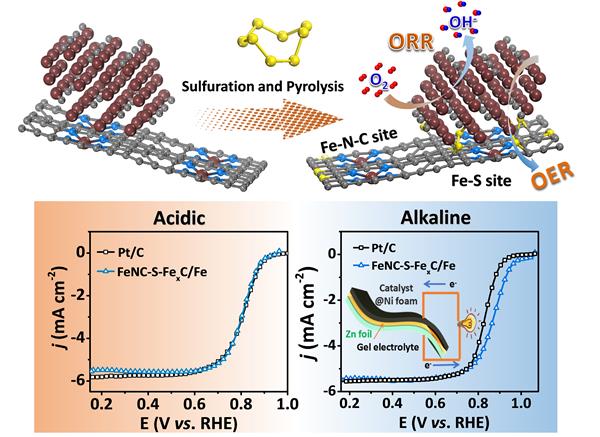Multiple atomic-level coupling active sites engineering: sulfurize Fe-N-C catalysts with FexC/Fe species to enhance the performance of oxygen reduction reaction in acid media and flexible Zn-air batteries
Yueyang Qiao, Pengfei Yuan, Yongfeng Hu, Jianan Zhang, Shichun Mu, Jihang Zhou, Hao Li, Huicong Xia, Jing He, Qun Xu

During the preparation of atomically dispersed Fe–N–C catalysts, it is difficult to avoid the formation of iron‐carbide‐containing iron clusters (“FexC/Fe”), along with the desired carbon matrix containing dispersed FeNx sites. As a result, an uncertain amount of the oxygen reduction reaction (ORR) occurs, making it difficult to maximize the catalytic efficiency. Herein, sulfuration is used to boost the activity of FexC/Fe, forming an improved system, “FeNC–S–FexC/Fe”, for catalysis involving oxygen. Various spectroscopic techniques are used to define the composition of the active sites, which include Fe–S bonds at the interface of the now‐S‐doped carbon matrix and the FexC/Fe clusters. In addition to outstanding activity in basic media, FeNC–S–FexC/Fe exhibits improved ORR activity and durability in acidic media; its half‐wave potential of 0.821 V outperforms the commercial Pt/C catalyst (20%), and its activity does not decay even after 10 000 cycles. Interestingly, the catalytic activity for the oxygen evolution reaction (OER) simultaneously improves. Thus, FeNC–S–FexC/Fe can be used as a high‐performance bifunctional catalyst in Zn–air batteries. Theoretical calculations and control experiments show that the original FeNx active centers are enhanced by the FexC/Fe clusters and the Fe–S and C–S–C bonds.
https://onlinelibrary.wiley.com/doi/full/10.1002/adma.201804504